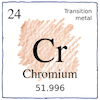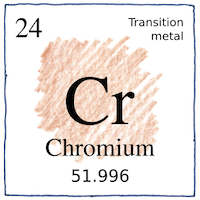Paris—Louis Nicolas Vauquelin
elements

|
Chromium
Louis Nicolas Vauquelin, pharmacist, chemist, and inspector of mines, extracted metallic chromium from Siberian red lead ore used as a red pigment, and showed that chromium gave rubies their red color.
Atomic number 24
Its oxide coated the bronze weapons of the buried terracotta army. * Its popular red and yellow pigments from crocoite. * Vauquelin named chromium after the Greek word for color. * Electroplated onto bumpers and trim, motorcycle and bicycle parts. * Making stainless steel stainless. * Primer paints with toxic hexavalent chromium. * Nontoxic chromium salts tan leathers. * Chrome yellow school buses.
Stuff that shines
If the handlebars of my first bike weren’t actually chromed, at least they were shiny. Likewise, the first car I ever loved was sky-blue Studebaker Lark four inches long. Deceived by color and shine, at least I’m not alone. It might not always be a thing’s intrinsic value that we love, but something that reflects our desire.



Trivalent chromium has been deemed to be an essential trace element, but lack of proof suggests that it is merely benign. It isn’t necessary for anyone to take chromium supplements who eats food prepared in stainless steel cookware, and those who are allergic to chromium or nickel are advised to cook with aluminum, enameled, or cast iron cookware.
See also in The book of science:
Readings in wikipedia:
Other readings: